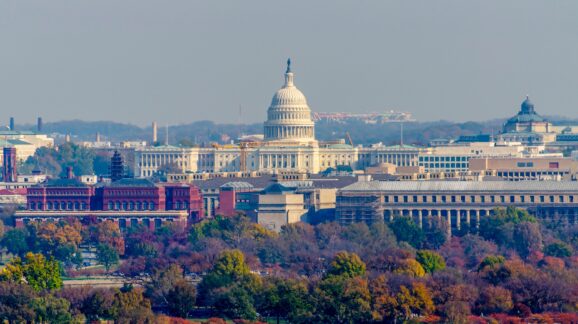America Needs an Emergency Declaration to End All Emergency Declarations

Photo Credit: Getty
Last night President Biden declared on 60 Minutes hat “The pandemic is over.” “If you notice, no one’s wearing masks, everybody seems to be in pretty good shape,” he volunteered. Accordingly, today, some policy makers are asking, “OK, then, what happens with the emergency declarations, emergency use authorizations, and vaccine mandates?”
There is no automatic phaseout of them, unsurprisingly. Expect a doubling down, instead. The Department of Health and Human Services (HHS) seems poised to renew an emergency COVID public health emergency authorization for the 11th time.
Emergencies are declared via statues like the National Emergencies Act and the Korean War-era Defense Production Act (DPA), which these days is notable for its central planning schemes for the likes of ventilators and baby formula. After invocation by a president, departments and agencies at times extend the declarations; in turn, the nation seems not to have a good grasp of their shelf life or expiration dates.
This is a phenomenon for which we at CEI—in a report called The Case for Letting Crisis Go to Waste—have called for an “Abuse-of-Crisis Prevention Act.” COVID, after all, was the third, not the first, crisis of the 21st century to which the response could have been something other than massively expanding the scale and scope of the central government.
The abuse of federal emergency declarations, whether from local tap water to HHS’ unwillingness to relent the public health emergency must be ended. The most elemental step is to eliminate or at least limit federal emergency statute use generally. Emergency declarations occur so often in even ordinary, predictable events like weather that insurance markets are mangled, leading to distortions that get magnified by federally subsidized insurance.
As for the arguably extraordinary “unexpected” shock or crisis (although unexpectedness is not a term that truly applies to pandemics or to financial meltdowns rooted in government-sponsored enterprises and indemnification of risk), the ambitions and alarming sweep of emergency powers were recognized well before the appearance of the novel coronavirus, but no lessons learned.
After the boost given to the Defense Production Act by the Trump administration for ventilators and non-medical-grade masks, Biden followed through on invoking the DPA still further. Some rent-seeking companies are and will be fine with that, such as if ongoing artificially induced supply shocks continue.
From health emergency preparedness to production pipelines, reducing the reliance on emergency declarations is vital in advancing societal resilience. Without a shift, it is likely that the DPA and related measures will be invoked immediately upon any future crisis, and even more aggressively.
The ARTICLE ONE Act (for Assuring that Robust Thorough, and Informed Congressional Leadership Is Exercised Over National Emergencies), sponsored by Sen. Mike Lee (R-UT) “would take back significant legislative powers given to the executive branch by the National Emergencies Act of 1976.” It would amend the National Emergencies Act to require Congress to vote to extend emergency declarations, as opposed to the current requirement that Congress vote to cancel a declaration (which is subject to veto). This is important, because emergencies deepen an already extraordinarily excessive centralization of federal power. Despite politicians’ rhetoric over cherishing of principles of federalism, that concept is not applicable to governments that do as much as ours does now.
Fortunately, most emergences are local rather than global. That entails adopting sound policies like clarifying distinctions between federal and state strategic stockpiles and maintaining them and maximizing household intergenerational wealth (as opposed to the current scheme of maximizing intergenerational federal debt) to enable citizens to help one another—rather than reflexively turning to Uncle Sam.“Un-declaring” emergencies would remove federal funding and impel states to act on their own (an astonishing $700 billion-plus of the federal budget consists of grants-in-aid to states), as would not issuing declarations in the first place.
For example, the distinctions between state duties and what exactly the Food and Drug Administration’s (FDA) National Strategic Stockpile inventory should consist of remain muddled. The federal FDA stockpile, scattered across the nation, was never intended to support every state simultaneously. Still, despite the inevitability of pandemic, the requisite stockpiles of tens of millions of masks and thousands of ventilators, mobile beds, other gear, millions of 2,000-calorie rations that would have cost a relative pittance were not available or had been dismantled when COVID hit. An example: The Los Angeles Times described a California program under then-Governor Arnold Schwarzenegger whereby about $200 million was spent to acquire mobile surge hospitals, millions of N95 masks, ventilators, and other pandemic-prep supplies. The arsenal was eliminated by his successor Jerry Brown to save few million, paving the way to put the rest of the nation on the hook in the form of federal rescue.
Part of the changes to expect after taming emergency declarations is greater assurance that state and local strategic stockpiles burst at the seams, figuratively speaking, in terms of localized decisions about resilience and readiness.
Along with tamping down on the reflexive flash-policy emergency declarations, there must be restrictions on recovery and emergency funds as such. Reformatting emergency declarations is part of a broader repudiation of the open-ended government expansion of the past two years, including by federal purchasing and contracting powers and by the abuse of “regulatory dark matter” in the form of guidance documents that don’t go through the rulemaking progress yet carry regulatory weight. In short, we need an emergency declaration that ends the abuse of emergency declarations.